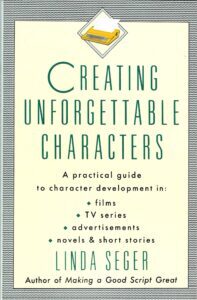Seger Adds Dimensionality to Characters

Linda Seger. 1990. Creating Unforgettable Characters: A Practical Guide to Character Development. New York: Henry Holt and Company.
Review by Stephen W. Hiemstra
When I was young, I relished the idea of becoming a farmer because I loved the outdoors and taking care of the animals. As I grew older my ambitions changed and my ideal job evolved into one where I would work with the beautiful people who were smart, witty, and always fashionable. In a word, these beautiful people were walking, talking characters.
In her book, Creating Unforgettable Characters: A Practical Guide to Character Development, Linda Seger writes:
“I will concentrate on the process of creating well-rounded individual characters, and characters in relationship…Character is created through a combination of knowledge and imagination.” (xiii)
Writing credible characters involves giving them multiple dimensions, both strengths and weaknesses. Dimensions include age, sex, education, religion, race, ethnicity, profession, attitudes, values, context, and many other attributes. Without this dimensionality, characters collapse into stereotypes and stick figures that are less realistic, relatable, or interesting, and totally forgettable.
Background and OrganizationLinda Seger graduated from Colorado College, received a Masters of Arts from the Pacific School of Religion on Religion in Arts, a Masters of Arts in Drama from Northwestern University, and a doctorate from the affiliated Graduate Theological Union. She is an author and screenwriter.
Seger writes in ten chapters:
Researching the characterDefining the character: Consistencies and paradoxesCreating the backstoryUnderstanding character psychologyCreating character relationshipsAdding supporting and minor charactersWriting dialogueCreating nonrealistic charactersBeyond stereotypingSolving character problems (ix)These chapters are preceded by a preface and followed by an epilogue, appendix, notes, and an index.
Researching the CharacterSeger’s first chapter begins with an analysis of a problem script. The script had already been sold, being described as “high concept,” which is the Hollywood designation for a well-structured, interesting plot. The problem revolved around the characters.
She writes: “I realized that she didn’t know enough about the context—about the world of the characters.” (1) The iceberg of the character included general information, but the specific information about the ten percent of the character world actually being written about was skimpy (2-3). It’s like the problem of the extinction of an interesting species because their particular habitat has disappeared (5). The species in question can only be described within the context of their particular environment.
This observation appears in the first chapter of her book, suggesting that this is a core problem with authoring characters. In my own experience, writers’ cramp is typically solved through additional research. My current novella, a split-time, young adult book that dives into first century Israel was a bear to write because every little detail was preceded by hours of research. Think of all the animals, like lions and big-horn Jacob sheep, that ran around in first century Israel, but are now extinct.
Solving Character ProblemsSurprisingly, character issues often flag other problems. One problem that Seger cites, is a character that explores an author’s own dark side. This came as a special surprise because it is hard to write about a subject that you shy away from in your own life (210). This same problem—an emotional hijacking—can arise in hospital ministry when a patient’s issue triggers an emotional response that is unexpected and not even perhaps manageable. It also arises in writing memoir when describing key turning points in your life that may not have been adequately processed.
Other character problems include:
A character that is only generally and vaguely described (210).A supporting character that appears to take over the story (212).A character problem that exposes a weakness in the story (213).One solution to a character problem is to explore their hidden agendas (214). Another is to place the character in relationship with another character (217). Still another solution is to subject the character to a series of what-if questions (219).
AssessmentLinda Seger’s Creating Unforgettable Characters: A Practical Guide to Character Development is an interesting and helpful resource for deepening a writer’s understanding of improving character dimensionality. It is the kind of craft book that I read to remind me of things to do and thought processes to pursue as I edit a manuscript. Perhaps you too will find it useful.
Seger Adds Dimensionality to CharactersAlso see:Books, Films, and MinistryOther ways to engage online:Author site: http://www.StephenWHiemstra.net Publisher site: http://www.T2Pneuma.com Newsletter at: https://bit.ly/bugs_25, SignupThe post Seger Adds Dimensionality to Characters appeared first on T2Pneuma.net.



